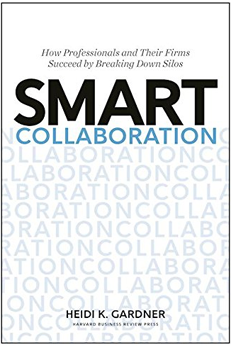Usefulness
Content
Freshness
Is your business potential locked in silos? Don’t break them without building a bridge to your future profits. With “Smart Collaboration: How Professionals and Their Firms Succeed by Breaking Down Silos”, a Harvard law professor and business expert helps readers learn how they use internal and external collaboration maximize their profits by closing their current operating capacity and their future potential.

Smart Collaboration: How Professionals and Their Firms Succeed by Breaking Down Silos is dedicated to service firms that exist in the knowledge economy encountering the complex problems of a VUCA (Volatile, Uncertain, Complex, and Anonymous) world. The book gives leaders of these firms two options, collaborate smart or hope for a miracle. The book provides strategies for leveraging collaboration as a firm’s unique asset.
What is Smart Collaboration About?
Heidi Gardner,Harvard law professor and author of Smart Collaboration, assumed (like most of us do) that the key to building an all-star team was picking all-star people. If you want a football or basketball championship, the belief goes, you recruit the top players. If you want the best startup, you get the smartest programmers that your money and resources can buy.
Unfortunately, that’s not what Gardner found at all.
Gardner’s research demonstrated that merely putting a team of experts or specialists on the same project wasn’t enough to guarantee a competitive advantage. It required putting that all-star team of experts or specialists together in the right way. That “right way” is the core of the internal and external “smarter collaboration” that is the topic of this book.
Reaching this level of smarter collaboration requires leveraging people and resources in a more proactive and dynamic way. Instead of mindlessly cobbling together a team quickly, it requires strategically filling in the talent and knowledge gaps for a long-term advantage. Instead of letting things happen organically, smarter collaboration proactively manages relationships and resources to reach a higher level of performance and business intelligence that can better address complex problems from a variety of perspectives and approaches. This higher level of collaboration allows organizations to offer more services, reach more customers, and retain both employees and customers.
Gardner. has worked at Harvard in several capacities including Distinguished Fellow of the Harvard Law School, a lecturer, Faculty Chair of Harvard Accelerated Leadership Program course and faculty member. Before working at Harvard, she worked as a management consultant and manager for Proctor and Gamble.
What Was Best About Smart Collaboration?
The best part of Smart Collaboration is Gardner’s deep insight into creating a collaborative team, a subject many leaders know a lot about intuitively. Gardner’s research demonstrates that there is a lot more to collaboration than meets the eye. The book takes this insight even further, demonstrating how collaboration serves as a competitive advantage in the unpredictable business world of the future.
What Could Have Been Done Differently?
The audience of Smart Collaboration is narrowly limited to leaders of high-end knowledge-based service businesses (i.e. financial services industries, management consulting agencies, etc.). The advice is given from the perspective of businesses that are global, have a large budget, and have resources to implement smart collaboration on a large scale. For businesses that don’t fit that mold, it is still possible to get a sense of what this creative collaboration might be like and how it could apply to your business. But readers might also get a little lost with some of the content.
Why Read Smart Collaboration?
That being said, the basic principles of smart collaboration offer a promising strategy for any forward-thinking business. While the book and Gardner’s insights may have been meant for a higher level knowledge based company, it’s easy to understand how they could apply to your small business too. Every business regardless of the size of its budget or the resources at its disposal rely on the collaboration of it’s core team. So whether you’re running a multinational investment firm or a little mom and pop retail store, much in this book could apply to you.
